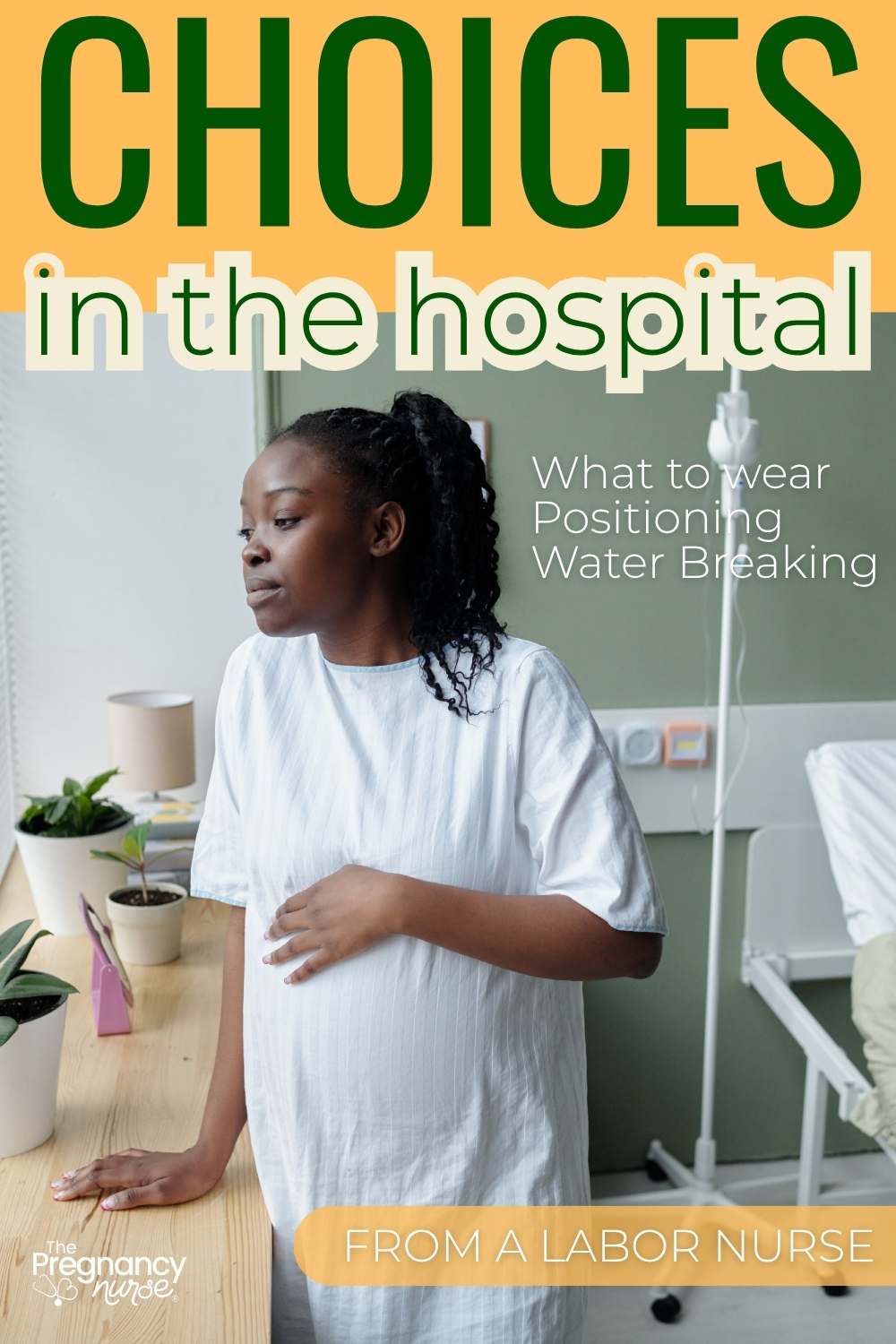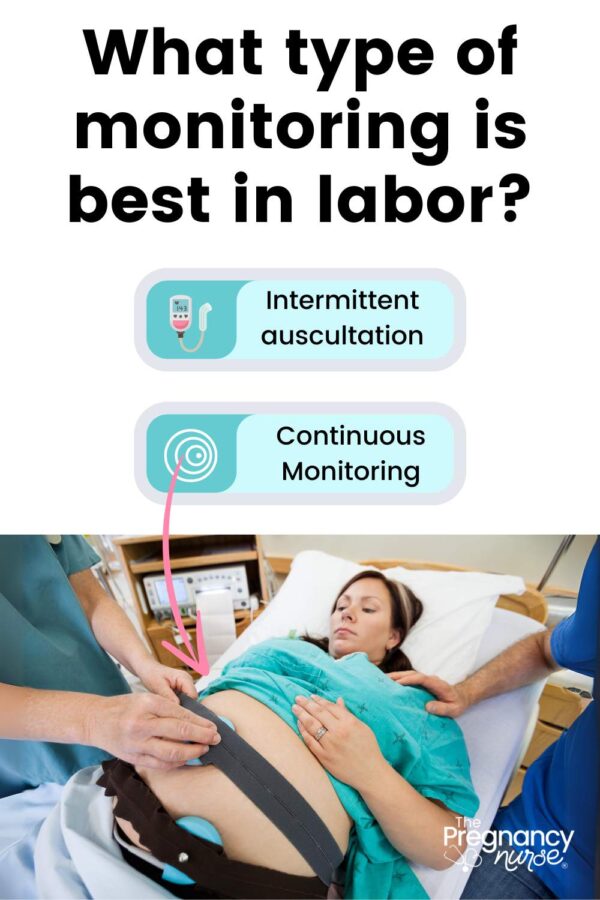📣 YOU are clearly getting prepared for pregnancy, birth & beyond — but do you wish your partner was more involved (looking for a teammate rather than just a cheerleader)? Couples love THIS! 💛🧡💚
I often hear doulas saying that a doula helps you know your choices during labor — but gosh, I know a doula is out of financial reach for a lot of you. Today I want to talk about some of the common choices that you have in labor — to help you understand that you always have options. I’m the first to admit that we’re not great at giving options, but these will get you started!

BTW, if you love some labor tips — check out my insider tips for a great birth:
I should also mention that with ANY choice you should discuss your options with your healthcare team. Some of these might really not be appropriate for you and sometimes emergencies happen (that’s why you’re in a hospital after all) — I just wanted to remind you of that before we get going!
What to Wear
This is a big one. As a nurse I have a gown laid out for every patient I see — and most take that option. You have to realize it’s important we do this. Many patients come to the hospital unprepared to be there. They won’t have their own gown or are prepared for this visit.
But, this does NOT mean you need to wear it.
Pro gown tip: It opens in the back. This allows our monitor cords to come through with some privacy for you. Plus, if you’re bleeding it doesn’t get on the gown if you leave it open on a pad on the bed.
We’ll often say bra and undies off when we tell you to get in the gown. Does this mean you HAVE to take that all off? No.
Some options here:
- Commando — go fully naked. It happens. Most people don’t start this way — but many end-up this way and we don’t mind at all.
- Wear a bra — if your bra doesn’t have metal, the risk of wearing it is pretty low. You just need to know there is always a chance we will have to cut it off, so I don’t recommend wearing your favorite bra.
- Wear your own gown — many people bring their own gown. That’s AOK with me — I just want you to know that labor is a messy process. Many will choose to throw the gown away (even if it’s washable) just because of ALL the things that get on it.
- Wear something else — I love a shelf bra tank top. Keeps your top covered, and we cover your bottom half with a sheet anyway (if that’s important to you).
I actually have a few posts on what to wear during labor:
- What to Wear For a Cesarean Section
- Do You Wear a Bra During Labor?
- Your Guide on What to Wear in Labor & Delivery and Your Hospital Stay
- How to Wear a Pregnancy Belly Band
Hopefully this is getting you started realizing you’ve got options! BUT we don’t often offer all of them because most patients are grateful for the hospital gown.
Ok, let’s keep going….
Where to Be
Well, you’re in the hospital — but you have options as to where your body will be (or what position you’re in).
I will admit that often, because we want to make sure that you and baby are safe, we love to have you lay down and quickly find baby on the monitor. However, after that — I think you’re good to move about the room (just like the stewardess always says).
That’s right, you can find the position that works for you.
Now, does that mean your baby will let us monitor them in that position? Not always. However, at that point you then decide what type of monitoring you want.
I have a few posts on that:
- What You Need to Know About Wired vs Wireless Monitors in Labor (this gives a lot of tips even if your hospital does not have wireless monitoring — or it doesn’t work — which happens a lot)
- Intermittent Auscultation: Who it’s for (and why it’s better) — this is getting a lot of play in the news lately, but the reporting is poor so get the full story from that article.
A few facts you need to know:
- If baby isn’t on the monitor there are things we can NOT do — which include running an induction or an epidural. If you decline monitoring with those, we will have to stop those things. Nurses could lose their license without them.
- Even with wireless monitoring, there are some positions the baby just can’t be monitored in, and it varies baby to baby.
- Your nurse may need to frequently adjust the monitor — we hate it, you hate it. You can always ask if there’s anything you can do to help. Sometimes just you resting a hand on it keeps us away a bit longer. And — sometimes your belly ends-up looking like arts and crafts with tape, and other things helping us keep baby on.
I always say that fetal monitoring (especially obtaining it– is an art, not a science) — and sometimes we have to get very creative.
There is a monitor called a fetal scalp electrode that goes into the very tip of the baby’s scalp to monitor their heart beat — and this normally allows more positions as we’re attached to baby. However, it does require your water broken, and can be a bit more invasive (and a bit more risky if you have GBS).
I also want to add that I am a HUGE fan of movement in labor — you just have to know that sometimes it requires some creativity. Which can still be done, even if you need wired monitoring. Positions can be tricky. There’s labor movement cards in here to give you ideas of positions to choose between.
Letting Them Break Your Water
I wish providers were better at giving a choice on this. Often I hear “I’m going to break your water” vs — “Would you like me to break your water”? But remember, it is ALWAYS your choice.
Honestly, if you’re in the hospital an your provider is going to check you — ask if they’re going to break your water. Some do it without asking. It’s wrong, but at least you have that conversation ahead of time.
I have a couple of posts that dive into this more:
- Should You Let Your Provider Break Your Water?
- Should You Get the Labor Epidural Before They Break Your Water?
Here’s the Cliff Notes of what you need to know:
- Breaking water is almost always a choice (there are a few times we sometimes have to do it urgently — but you’ll sense it’s different).
- Studies show that breaking it in early labor isn’t particularly helpful at making labor progress faster. However, if you’re early in labor and not progressing, they may think it might help. It’s worth a try if they do. I go more into the the studies in this post.
- Often your contractions feel more painful once your water is broken. Think of it as squeezing a full water balloon vs a mostly-empty one — you can just squeeze harder, that’s what your uterus is doing.
- Some babies don’t love having the water broken and it can (although rarely) lead to a c-section — so, you want to be sure of your choice — that the pro’s outweigh the cons.
- It is true that as you progress into active labor (so, this is past 6 cm normally) sometimes breaking water is necessary to let labor progress. Sometimes the bag of water is bulging and just can’t push on the cervix enough to open it up and let baby descend.
So often I’ll hear doulas say on social media “don’t let them break your water” — but as I hope you’ve seen, this is a nuanced discussion that requires knowing what’s going on at THAT moment. This is why you have experts in the room — doctors, nurses and YOU (you’re an expert in your own needs).
Let me just say that far too often people make these choices simple when they can have a lot of complicating factors. I really recommend learning more about all your options in labor — I recommend this.
Want to know more about hospital routines — check out these posts:
- How to Push During Labor (What No One Explains)
- How to Feel Confident Making Choices During Labor
- What To Do If Labor Isn’t Progressing?
- Secret Keys to Labor that No One Talks About
- The Three Biggest Mistakes Labor Patients Make—And How to Prevent Them
Eating
This one gets a lot of talk online — and honestly, for good reason.
For a long time we just haven’t given anything more than clear liquids (think: liquids you can see through) to people in labor. BUT the studies are showing this isn’t necessary for most people.
Clearly the choices are:
- Eat real food (either brought in from home/restaurant or what the hospital provides)
- Just drink clear liquids
- Don’t eat at all
And all of those choices are right for some people.
Decent chance of a cesarean section (think twins, or a baby that has been having issues for a while in labor) — not eating is probably your best bet so you don’t have issues with anesthesia.
Real food makes you want to die, but could use a little sugar boost — maybe ask for a popcicle?
Starving? Eating some real food might be awesome for you! More and more we’re seeing that a little food can help your body get the energy it needs to help labor progress — especially if it’s been a long time.
Hospital Pro Tip: Your nurse can actually only do what your doctor orders. SO, if they say you can’t eat she can’t provide you with food. That doesn’t mean you can’t eat — it’s just part of how the hospital works. But always understand the risks and the benefits, even before you do simple things like eating.
Why is this a big deal? Mostly anesthesia worries that if you were to have a cesarean section and need general anesthesia you can vomit and that can go into your lungs. It’s less problematic if you haven’t eaten, but clearly we don’t want food in our lungs — which is why anesthesia is adamant about this.
However, there really aren’t many patients who go to general anesthesia…. so…. there’s that.
Again, talk about your options, and make the choice that is right for YOU!
Other Choices….
Now, labor is full of choices — and I think it’s awesome to think of them ahead of time. Which is why I have a free birth plan series where I walk you through it and how to use it:
But, a birth plan is not a plan for your birth. It’s just you thinking through your options about what you’d like. It’s honestly like looking a menu over in advance — knowing, sometimes the restaurant is out of things and you’ll have to choose something else. But, you know what “mood” you’re in.
You then have to know how to apply those choices to the circumstances (and knowing some of your options). Having a foundation of knowledge for your birth is a key to this one. I recommend this.
So, what other choices are you thinking about for YOUR labor? I’m actively working on making content around choices in labor — so I’d love to know what you’d like to know more about. Tell me down in the comments!







 How to Push During Labor (What No One Explains)
How to Push During Labor (What No One Explains)
